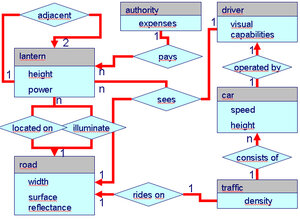0LAB0 - Introduction to Modeling: dynamic systems
Contents
The contents comprises the generic part (identical for all participating students) and a specific part (may differ among students).
The generic part comprises the following topics:
- Model, problem domain and model domain; representation; types of modeling purposes and the various types of models (taxonomy);
- Quantities, types of quantities (dimensions and units, compound variables and objects), and the roles to be played by quantities (chosen, desired, measured, derived);
- Relations between quantities I (functions; constructing mathematical expressions that need to comply with desired features; some aspects of the analysis of functions of multiple variables; tables interpreted as functions; the difference between functions and equations; dimension analysis to construct or verify expressions, simple examples of the pi-theorem; the systematic derivation of a causal, stationary model by subsequent functional definitions of quantities; the concept of 'linearity', with its advantages and limitations;
- Relations between quantities II (networks, hierarchy, systems, components, interfaces; introduction to other forms of formal modeling than linear algebra / analysis / calculus);
- Manipulation with statical models (evaluation, optimisation, sensitivity and sensitivity analysis, monotonicity, order-of-magnitude estimates and asymptotic reasoning to understand the behaviour of a statical model);
- Manipulation with dynamical models (the notion of 'time', discrete and continuous time dependency, processes and simple process models, the notion of a finite automaton, evolution, simulation , convergence and stability).
The specific content:
- You are able to determine the system boundary of a physical phenomenon and its environment.
- You have insight in the choice of the time window in which you describe the phenomena, and in the physical units of variables and components and their use in formulas.
- You understand that the interaction between components of physical models is well-described by power exchange. For simple physical models you are able to recognise the input and energy buffers.
- You know the relation between the energy stored in a buffer and a state.
- You are able to derive a state model, in which the time-derivative of the state is a function of the state and input of the process only. The output is a function of the state and the input only.
- You recognise the two variables which determine the power in the domains of electrical engineering, mechanics (translation and rotation) and thermal systems. You recognise the generic components R (resistantance, friction), C (capacity, spring), and L (inductance mass, inertia) for the domains electronical engineering, mechanics and thermal systems.
- You have insight in the equivalence and analogies of the domains of electrical engineeering, mechanics and thermal systems. You know how to apply equivalent mass or inertia when translation and rotation are directly coupled. You know the ideal power converters such as a transformer, a gear box and an electric motor.
- Based on the law of mass conservation and mass and using buffers you are able to describe mass transportation [kg] and chemical reaction equations [mol] by means of a state model.
Learning objectives
The learning objectives of the course comprise of a knowledge component, a skills component, and an attitude component.
- Knowledge component: students acquire knowledge about [1]:
- the purpose, the use and the organisation of modeling processes;
- a vocabulary to argue about the modeling process (including such terms as 'model', 'quantity', 'validation', 'approximation', 'assumption', 'sensitivity'), and the application of this vocabulary in an application domain.
- generically applicable methods and techniques, to be used in various modelling contexts (linearization, interpolation, optimisation, simulation);
- Skill component: students acquire skills to:
- identifying and giving a precise formulation of a problem;
- translating this problem into a simple mathematical model;
- consciously making choices, approximations and assumptions while constructing the model;
- deploying the model for solving the initial problem;
- assessing reliability, validity, adequateness of the results found;
- when necessary: refining the model;
- translating the results, obtained from the model, back to the initial problem;o reflecting on one's own modelling process;
- Attitude component: students acquire an attitude of:
- carefulness: claims, derived from a model, always have a limited validity, and should not be applied beyond the scope of the underlying assumptions and approximations;
- daring: building a model requires taking decisions, cutting knots, and making educated guesses and other, not fully justifiable steps;
- openness and receptiveness against other than the own discipline: a practical problem will generally not be limited to a single discipline, and in general, models therefore need to encompass various disciplinary perspectives.
[1] This knowledge is assessed implicitly. The elaborations of the homework exercises and the reports of the modelling assignment are assessed, among other things, for the adequate usage of the vocabulary and the knowledge of the generic methods covered in the lectures. In particular in the homework exercises, the purpose, the use and the organisation of concrete modelling processes may be quizzed.
